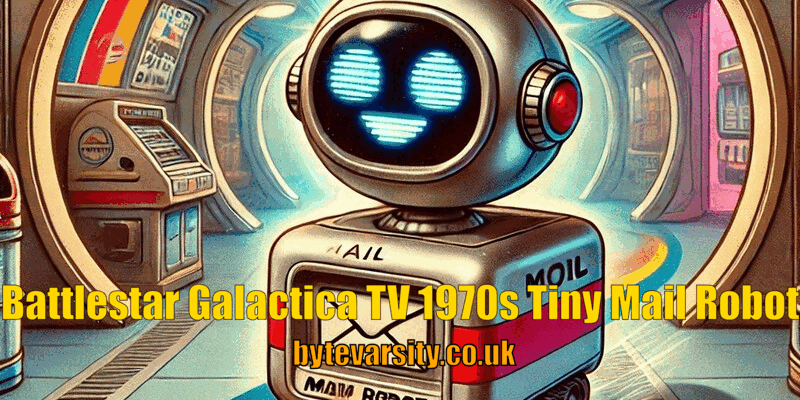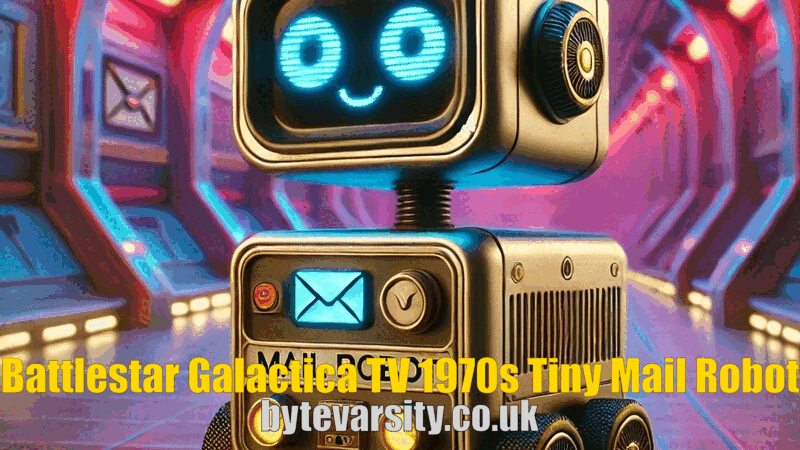Introduction
A Nostalgic Icon of 1970s Sci-Fi
Battlestar Galactica, the groundbreaking 1978 sci-fi series created by Glen A. Larson, captivated audiences with its gripping tale of humanity’s survival against the menacing Cylons. Amid the epic space battles and deep philosophical themes, a charmingly simple character emerged: the tiny mail robot. This small, wheeled droid brought humor and warmth to the intense narrative, quickly becoming a fan favorite for its blend of practicality and charm.
Far from just a prop, the mail robot symbolized the series’ optimistic view of technology. Its cheerful design and understated role as a communicator aboard the Battlestar highlighted themes of connection and community. Decades later, this endearing creation continues to hold a special place in the hearts of fans, reminding viewers of an era when imaginative storytelling and practical effects shaped unforgettable worlds.
When Battlestar Galactica debuted in 1978, it captivated audiences with its compelling sci-fi narrative and groundbreaking visual effects. Among the stars of this futuristic universe was an unexpected fan favorite—the tiny mail robot, or “mailboat,” that dutifully zipped through the Battlestar, delivering messages and adding a touch of whimsy to the series’ often intense storyline. Today, this charming automaton has become a beloved symbol of sci-fi nostalgia, representing both the innovative spirit of 1970s television and the enduring power of small details to capture the public’s imagination.
Related: TV Services
The Origins and Lasting Influence of Battlestar Galactica
Battlestar Galactica, created by Glen A. Larson, first aired in 1978, inspired by the sci-fi wave created by Star Wars. It introduced viewers to a gritty universe where humanity’s survival depended on outsmarting the relentless Cylons. With its blend of high-stakes space drama and relatable human dilemmas, Battlestar Galactica quickly became a cultural touchstone. Decades later, its themes of identity, survival, and the ethics of technology still resonate with fans and continue to influence sci-fi storytelling, reminding viewers of a time when television relied on imaginative production design and practical effects to build entire universes on screen.
Key Characters and Themes that Defined the Series
The show’s core characters, including Commander Adama, Apollo, and Starbuck, were layered archetypes representing resilience, courage, and adaptability in the face of immense challenges. While the Cylons loomed as a menacing representation of technology gone awry, the tiny mail robot provided a lighter contrast—a friendlier side to futuristic tech. Through its simple, repetitive tasks, the mailbot became a comforting presence, underscoring the series’ emphasis on community and connection even amidst chaos.

The Tiny Mail Robot: Design, Features, and Fan Appeal
One of the unique design highlights of Battlestar Galactica was the tiny mail robot, affectionately remembered for its petite, round body and cheerful mechanical “face.” This little helper embodied the optimistic view of technology that was prevalent in 1970s sci-fi. Its metallic sheen, blinking lights, and expressive yet simple design made it an ideal mascot for a series set against the backdrop of intergalactic conflict. While it may have had limited dialogue or screen time, its frequent appearances delivering messages and navigating the ship’s hallways gave fans a touchstone of humor and warmth.
Functional Charm: Why the Mail Robot Became Memorable
The mailbot’s functionality went beyond novelty. It became a symbol of daily life aboard the Battlestar, often delivering pivotal communications that influenced character decisions and subtly advanced the plot. In high-tension moments, the mailbot’s arrival with a message often defused stress, reminding both characters and audiences of the small, reassuring constants even in a universe marked by upheaval. This mix of functionality and charm made it a nostalgic emblem of the show’s personality, particularly for fans who continue to appreciate the balance of drama and levity it provided.
The Role of the Mail Robot in Show Themes and Storytelling
The mail robot might seem like a minor character, but it symbolized the importance of connection and communication, themes central to Battlestar Galactica’s storyline. It served as both a literal and figurative messenger, often underscoring moments of collaboration and trust—essential qualities for the Battlestar’s crew in their battle against the Cylons. In a world where technology was both ally and enemy, the mailbot reinforced the idea that machines, like people, could have a positive impact when used constructively. This contrast between the friendly mailbot and the menacing Cylons highlighted the series’ nuanced portrayal of technology and its potential dualities.
The Cultural Legacy of the Tiny Mail Robot
With renewed interest in Battlestar Galactica thanks to streaming platforms, the tiny mail robot has continued to capture fans’ hearts, serving as a nostalgic link to the era of practical effects and imaginative design. Fans and critics alike have revisited its role as a subtle but meaningful part of the show’s narrative, often emphasizing how it added a relatable, endearing element to the series. Today, fan merchandise, artwork, and discussions on forums celebrate the mailbot, proving its lasting appeal. It represents a cherished part of sci-fi history, highlighting the ways even small details in a show can leave a profound impact on audiences.
The Mailbot’s Influence on Modern Sci-Fi and Robotics in Pop Culture
The tiny mail robot’s legacy extends beyond Battlestar Galactica. Its influence can be seen in later sci-fi series and movies that have incorporated similarly quirky, loveable robots, like R2-D2 in Star Wars, BMO in Adventure Time, and WALL-E in Pixar’s WALL-E. These characters share the mailbot’s mix of utility, humor, and charm, continuing a tradition of robots designed to connect with audiences on an emotional level. In an age of advanced AI and robotics, this nostalgia for the charmingly simple mailbot reminds us of a time when robots in pop culture were designed as helpful, optimistic figures rather than ominous beings.
Reviving 1970s Sci-Fi Nostalgia in the Modern Era
The revival of interest in retro sci-fi series like Battlestar Galactica speaks to audiences’ yearning for the creativity and idealism of past eras. Streaming platforms have made it easier than ever for viewers to experience classic shows, drawing in new fans and reuniting original audiences with beloved characters. In an age of hyper-realistic CGI and complex storylines, the simpler, optimistic themes of 1970s sci-fi offer a refreshing escape, reflecting an era where shows like Battlestar Galactica dared to explore moral and philosophical questions while embracing the wonder of futuristic technology.

The Tiny Mail Robot as a Nostalgic Emblem of an Iconic Era
More than just a quirky detail, the tiny mail robot represents a time when sci-fi dared to be both hopeful and introspective. For fans, it symbolizes memories of watching Battlestar Galactica with friends and family, recalling an era when sci-fi reflected a more optimistic vision of technology. The mailbot’s enduring appeal lies in its ability to embody the creativity and joy of that era—a comforting reminder of the past that continues to inspire future generations of sci-fi storytellers.
Conclusion
The tiny mail robot from Battlestar Galactica stands as a nostalgic icon, capturing the enduring appeal of 1970s sci-fi. Its whimsical design, role in the series, and continued cultural impact showcase how even small, seemingly minor elements can contribute to a show’s legacy. As audiences revisit Battlestar Galactica and discover the show’s timeless charm, the tiny mail robot remains a testament to the series’ creativity and the power of imagination in storytelling. Decades later, it continues to inspire, reminding us that in both fictional universes and the real world, even the smallest characters can make the biggest difference.
FAQs About the Battlestar Galactica 1970s Tiny Mail Robot
Q1: What is the tiny mail robot in the 1970s Battlestar Galactica?
The tiny mail robot, commonly referred to as “Boxey’s Mail Robot,” is a small, wheeled droid featured in the original Battlestar Galactica series from the 1970s. While its screen time was minimal, it stood out as a quirky background character assisting in tasks aboard the Battlestar.
Q2: What purpose did the tiny mail robot serve on the Battlestar?
In the context of the show, the mail robot was depicted as a utility droid used for delivering messages and documents across the massive starship. Its functionality added a layer of realism to the advanced, futuristic world of Battlestar Galactica.
Q3: Was the tiny mail robot a recurring character in the series?
No, the mail robot was more of an occasional appearance than a recurring character. It served as a minor but memorable piece of the show’s set design, emphasizing the technological ambiance of the Battlestar.
Q4: Who designed the tiny mail robot for Battlestar Galactica?
The tiny mail robot was designed by the show’s prop and effects team, who were responsible for creating the mechanical and robotic elements of the series. The design was inspired by the need to showcase futuristic utility robots.
Q5: Was the tiny mail robot a practical prop or a remote-controlled device?
The mail robot was a practical, remote-controlled prop operated by the crew off-camera. Its movements were simple, emphasizing its role as a functional, rather than flashy, piece of technology.
Q6: Is the tiny mail robot connected to any other Battlestar Galactica spin-offs or reboots?
No, the mail robot was exclusive to the original 1970s series and has not been featured in any subsequent spin-offs or the 2004 reboot of Battlestar Galactica. However, it remains a nostalgic element for fans of the original show.
Q7: Why is the tiny mail robot still remembered by fans?
Fans of Battlestar Galactica cherish the tiny mail robot for its charm and unique design. It symbolizes the creative vision behind the series’ portrayal of life aboard a futuristic starship and is a fun nod to 1970s sci-fi aesthetics.
Q8: Can I buy a replica of the tiny mail robot?
There are no official replicas of the tiny mail robot currently on the market. However, some fans have created custom models or DIY replicas to celebrate this niche piece of sci-fi history.
Q9: Did the tiny mail robot inspire any similar designs in other sci-fi series?
While not directly credited, the tiny mail robot may have influenced the design of utility droids and robots in subsequent sci-fi shows and films, showcasing the lasting impact of the 1970s Battlestar Galactica.
Q10: Are there any behind-the-scenes stories about the tiny mail robot?
Although not much has been documented about the tiny mail robot specifically, the prop team for Battlestar Galactica often improvised with available materials to create futuristic devices, likely including this robot. Its simplicity and charm reflect the resourceful creativity of the era.